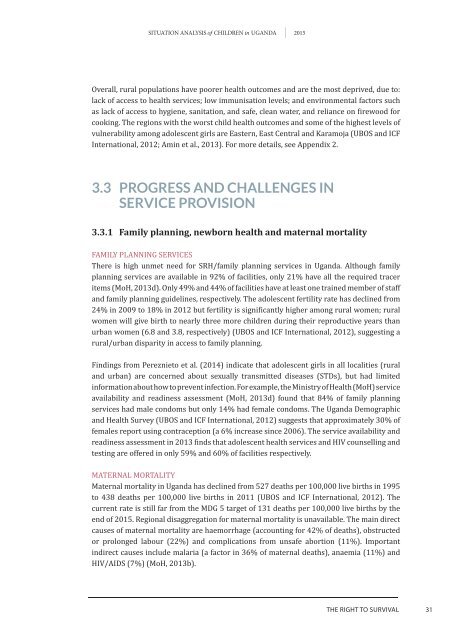Situation analySiS
1TNu802
1TNu802
Create successful ePaper yourself
Turn your PDF publications into a flip-book with our unique Google optimized e-Paper software.
<strong>Situation</strong> <strong>analySiS</strong> of Children in uganda 2015Overall, rural populations have poorer health outcomes and are the most deprived, due to:lack of access to health services; low immunisation levels; and environmental factors suchas lack of access to hygiene, sanitation, and safe, clean water, and reliance on firewood forcooking. The regions with the worst child health outcomes and some of the highest levels ofvulnerability among adolescent girls are Eastern, East Central and Karamoja (UBOS and ICFInternational, 2012; Amin et al., 2013). For more details, see Appendix 2.3.3 PROGRESS AND CHALLENGES INSERVICE PROVISION3.3.1 Family planning, newborn health and maternal mortalityFAMILY PLANNING SERVICESThere is high unmet need for SRH/family planning services in Uganda. Although familyplanning services are available in 92% of facilities, only 21% have all the required traceritems (MoH, 2013d). Only 49% and 44% of facilities have at least one trained member of staffand family planning guidelines, respectively. The adolescent fertility rate has declined from24% in 2009 to 18% in 2012 but fertility is significantly higher among rural women; ruralwomen will give birth to nearly three more children during their reproductive years thanurban women (6.8 and 3.8, respectively) (UBOS and ICF International, 2012), suggesting arural/urban disparity in access to family planning.Findings from Pereznieto et al. (2014) indicate that adolescent girls in all localities (ruraland urban) are concerned about sexually transmitted diseases (STDs), but had limitedinformation about how to prevent infection. For example, the Ministry of Health (MoH) serviceavailability and readiness assessment (MoH, 2013d) found that 84% of family planningservices had male condoms but only 14% had female condoms. The Uganda Demographicand Health Survey (UBOS and ICF International, 2012) suggests that approximately 30% offemales report using contraception (a 6% increase since 2006). The service availability andreadiness assessment in 2013 finds that adolescent health services and HIV counselling andtesting are offered in only 59% and 60% of facilities respectively.MATERNAL MORTALITYMaternal mortality in Uganda has declined from 527 deaths per 100,000 live births in 1995to 438 deaths per 100,000 live births in 2011 (UBOS and ICF International, 2012). Thecurrent rate is still far from the MDG 5 target of 131 deaths per 100,000 live births by theend of 2015. Regional disaggregation for maternal mortality is unavailable. The main directcauses of maternal mortality are haemorrhage (accounting for 42% of deaths), obstructedor prolonged labour (22%) and complications from unsafe abortion (11%). Importantindirect causes include malaria (a factor in 36% of maternal deaths), anaemia (11%) andHIV/AIDS (7%) (MoH, 2013b).thE rIGht to SUrvIvaL31




